Hanging in the center of the Martha’s Vineyard Museum’s new exhibit is a handmade wampum belt that tells the story of Aquinnah Wampanoag history.
To create the belt, Donald Widdiss, an Aquinnah Wampanoag artist, harvested hundreds of quahog shells to carve over 1,000 white and purple beads he then steadily wove into the belt.
“[The wampum bead] is not a bead, it’s a part of the land and traditional people look at the land as not being separate from you and I,” said Mr. Widdiss during a talk at the exhibit’s opening reception last Friday. “I’m just a messenger and the bead is a part of my message.”
The new exhibit is titled Generations, and includes art by Donald Widdiss, his mother Gladys, and his sons Heath and Jason. Donald and Jason are both wampum artists, whereas Gladys and Heath’s medium is clay.
Donald began making the intricate wampum belt over a year ago when the museum first approached him about the possibility of an exhibit. Kate Logue, the associate curator of exhibits at the museum, said they wanted to show his art, along with the art of his family, to teach the community about traditional Wampanoag crafts that continue to thrive in Aquinnah.
“A lot of people think of Native people as being something of the past,” Ms. Logue said. “This is just one more example of reminding people that the Wampanoag people are still here and still active and still very much engaged with the land that is theirs.”
Gladys Widdis was an avid potter who shaped clay harvested from the Aquinnah Cliffs into small pots and canoes.
“You get who you are from your Mom,” Mr. Widdiss said in a video on display in the exhibit. “That bond cannot be broken.”
As a child, Mr. Widdiss harvested clay from the Aquinnah cliffs to give to his mother for her pottery. Later, he would sit with Gladys at a folding table filled with her pottery, waiting for tourists to get off the bus and make purchases.
Gladys was Tribal Council President from 1979 to 1987. She died in 2012.
As part of her art, she refused to use a potter’s wheel and shaped each piece using a hand-building technique. She signed the bottom of her pots with a carving of a cranberry. Some of her clay pots and canoes are on display in the exhibit, along with four audio recordings from interviews with her.
“[Gladys] played a significant role in the tribe, getting federal recognition and getting common land back,” Ms. Logue said.
Heath Widdiss is the owner of Gay Head Pottery, following in the artistic footsteps of his grandmother. He also uses clay from the Aquinnah cliffs and spins the red, white, brown and yellow colors until his pots are decorated with vibrant streaks. Several of his pieces are inspired by Gladys, who had a similar style.
Jason Widdis, the owner of Wayward Wampum, learned to carve quahog shells into delicate shapes from his father. One of his wampum bracelets hangs in the exhibit besides text that describes how his art connects him to his Wampanoag roots.
When discussing potential elements for the exhibit, Donald suggested including multimedia to help tell his family’s story. Indaia Whitcombe, a Vision Fellow who works for the museum, followed him with her camera as he collected quahaug shells, carved them into beads and wove them into the belt. Her film is on display as part of the exhibit.
Above the wampum belt, there is also a projection of Richard Sandler’s footage of various locations on the Island, highlighting the land from which Donald’s art is created.
Donald said he hopes the exhibit will teach people about Wampanoag history and way of life. But above all, he would like people to leave the exhibit inspired to protect the Island he loves.
“I sincerely hope everyone appreciates what’s on the wall,” Donald said. “...for those of you who live here, all I can say is take care of [the Island].”










Comments (1)
Comments
Comment policy »